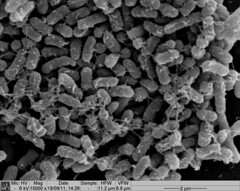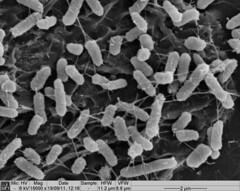Team:Glasgow
From 2011.igem.org
(Difference between revisions)
Chris Wood (Talk | contribs) |
|||
| Line 39: | Line 39: | ||
<p> | <p> | ||
<font size="1" color="grey"> | <font size="1" color="grey"> | ||
| - | Ranaspumin2 foam tagged with LOV - | + | Ranaspumin2<sup>1</sup> foam tagged with LOV - |
Picture courtesy of Prof Malcolm Kennedy, University of Glasgow </p> | Picture courtesy of Prof Malcolm Kennedy, University of Glasgow </p> | ||
</td> | </td> | ||
| Line 91: | Line 91: | ||
</br></br> | </br></br> | ||
<h4> References </h4> | <h4> References </h4> | ||
| - | Mackenzie et al., 2009. Ranaspumin-2: structure and function of a surfactant protein from the foam nests of a tropical frog. Biophysical Journal, 96, pp. 4984-4992. | + | <p> |
| + | 1) Mackenzie et al., 2009. Ranaspumin-2: structure and function of a surfactant protein from the foam nests of a tropical frog. Biophysical Journal, 96, pp. 4984-4992. | ||
| + | </p> | ||
</body> | </body> | ||
</html> | </html> | ||
Revision as of 18:15, 20 September 2011

DISColi: Bio-photolithography in Device Engineering Using Different Wavelengths of Light
Highlights!
In the course of our project we have created many noteworthy biobricks and have made a series of very interesting discoveries. Here are our personal highlights, including our favourite biobricks, our new chassis, and our public presence. Have a look!
E.coli Nissle 1917
Our new transformable, non-pathogenic, biofilm-forming chassis!LOV2 and iLOV Reporters
LOV2 and iLOV are our incredible new reporters. Not only are they smaller, florescene brighter and recover from photobleaching faster than GFP but it also functions in anaerobic conditions! Try tagging your favorite proteins.c-di-GMP Phosphodiesterase
c-di-GMP Phosphodiesterase breaks down c-di-GMP, which is a secondary messenger which regulates many behaviours such as motility and biofilm formation. Over-expressing this phosphodiesterase should decrease the levels of c-di-GMP, increasing cellular motility and causing biofilm dispersal. c-di-GMP has many more functions making this biobrick useful in a wide range of applicationsSponsors
With many thanks to our generous sponsors, without whom this project would not have been possible.
References
1) Mackenzie et al., 2009. Ranaspumin-2: structure and function of a surfactant protein from the foam nests of a tropical frog. Biophysical Journal, 96, pp. 4984-4992.
 "
"






